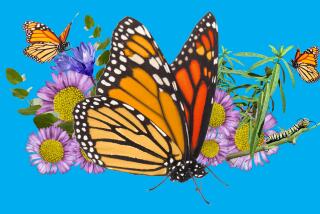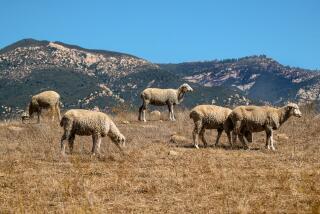Who Spreads the Weeds? Don’t Bet on the Horse
Some California university students and their department chairman have launched an unusual study of an ordinary substance -- horse manure -- that could help protect the state’s parklands from invasive plants. And protect the reputation of horses all over.
The study is the first scientifically rigorous effort to determine if noxious weed seeds accidentally consumed by horses end up spreading the weeds into new territory through horse droppings, as many outdoors enthusiasts have long believed. Fears of contaminating virgin lands with rogue plants have already caused several states to require expensive certified weed-free feeds for horses using public lands.
“Weeds are an enormous problem in our nation’s parks,” said Holly Bundock, a spokeswoman for the National Park Service, one of numerous federal, state and county agencies charged with the never-ending battle against weeds.
But weeds are not just aesthetically displeasing, said Rita Beard of the Park Service’s Biological Resource Management Division.
“Invasive weeds like the yellow star thistle systematically seek to create their own monoculture on wild lands,” she said. By taking over large land areas aggressively, they consume sparse moisture and destroy the biodiversity that wildlife and insects depend on for food and shelter. Some weeds, such as the knapweed family, even create a zone of poisoned soil around each plant that prohibits growth of other plants.
Completely halting the spread of seeds in the wild is a hopeless task, given that nature has designed them to propagate so well. Seeds have the ability to float on wind, to be consumed by birds and expelled, or to grasp onto passing animal fur. But humans also inadvertently accelerate the emigration of seeds to new territory in the mud on mountain bikes, off-road vehicles and even in the hooves of animals and boots and clothing of hikers.
Many have long suspected horses too. Bundock says the new study, being conducted by Dominican University in San Rafael with a $100,000 Park Service grant, is still a year from completion and officials are reluctant to draw conclusions yet. But preliminary indications from Northern California sites indicate the horse as demon weed-seed spreader may actually be a rural legend. The study expands into Southern California this year.
“Weeds make a fire problem,” Bundock added. “Weeds make a drought problem. Weeds make erosion problems. Weeds are very serious and they’re becoming a more serious problem every year. Thirty years ago we rarely had wildfires in the desert. Now dried weeds have created abundant fuels there.”
Federal and state land management agencies have long had in place integrated weed management strategies to combat existing populations of undesirable plants. Less focused have been efforts to prevent new infestations, and increased human use of wild lands also creates increased opportunities for further spreading.
Last year the Park Service awarded the grant to Dominican to study the perceived problem of horses and to devise a variety of public educational materials to combat the spread of weeds. One result, for example, has been pilot tests of a simple mountain bike tire scrubber to remove clinging mud and its tiny cargo of seeds at trailheads.
Horses are frequent visitors to roadless park areas transporting both riders and supplies.
More than 700,000 horses a year cross onto national park land in California alone, according to one estimate. They consume hay, grains and available grasses. Requiring that the animals be fed certified weed-free feed imposes significant costs on owners and others. But would that make any difference in curbing weed spread?
“We’ve had all sorts of comments, assumptions, hypotheses and anecdotes,” said Sibdas Ghosh, head of Dominican’s department of natural science and a research leader. “Many believe that seeds pass through the horse gut and, once in horse manure, they sprout and germinate in a new location. Theoretically, these could involve noxious weeds.” But Ghosh’s research of the professional literature on weeds and wild lands found this widespread belief based on absolutely no documentation.
Ghosh, colleague Mietek Kolipinski and their students developed a strict scientific protocol to guide the studies. They employed student biology majors to collect dozens of horse manure samples from trail, paddock and pasture sites in the Bay Area. This year, they will report on additional collections from both Northern and Southern California.
The samples were separated, labeled and cultivated in weed-free soil in small pots at a university greenhouse free of contamination. Of the 90 pots, 34 plants germinated in 21 of them. All plants were then identified by a native-plant specialist. They included toad rush, dooryard knotweed, summer mustard, bur-clover, purslane, cheeseweed and 25 Italian ryegrass plants.
Some of the cultivated plants were nonnative to the areas where that manure sample was collected. But none of them was listed by California’s Department of Food and Agriculture as a noxious weed, probably indicating the horses are already eating weed-free feed, avoiding such plants and not spreading weeds. The next round of tests will determine if that initial pattern holds true for horses in the rest of the state.
“While we await the study results,” Bundock said, “we can still proceed with an aggressive education program to make individuals aware of their potential role in spreading weeds.”
*
(BEGIN TEXT OF INFOBOX)
Alien invaders
Public land managers are trying to stem the spread of invasive plants, which are referred to as noxious weeds. Most of the weeds listed below spread quickly and displace native vegetation.
Puncturevine (Tribulus terrestris), from Mediterranean region
Description: Yellow flowers on prostrate stems up to 2.5 feet long
Problem: Foliage is toxic to livestock, especially sheep, when consumed in quantity. Produces many stout-spined burrs that can injure people and animals and puncture bicycle tires.
*
Yellow star thistle (Centaurea solstitialis), from southern Europe.
Description: Up to 6 feet tall
Problem: Plants typically develop impenetrable stands. Causes a disease in horses that permanently damages the animal’s ability to control fine motor skills, including mouth and lip movements.
*
Hydrilla (Hydrilla verticillata), from Eurasia
Description: Green aquatic plant
Problem: Aggressively forms dense stands or large subsurface mats. Pieces that break off form new plants, making eradication difficult.
*
Diffuse knapweed (Centaurea diffusa), from southeast Eurasia
Description: Bushy weeds with white, pink or pale purple flowers atop a spiny bract. Reaches 2 feet tall.
Problem: Usually forms large, dense infestations. Produces toxins that affect other plants, often displacing native vegetation.
*
Gorse (Ulex europaeus), from Western Europe
Description: Spiny evergreen shrub, up to 10 feet tall, with yellow pea-like flowers.
Problem: Mature plants, which form thickets, contain flammable oils. Older shrubs develop center of dead material and are highly flammable. Branchlets end as thorns.
*
Scotch broom (Cytisus scoparius), from southern Europe, northern Africa
Description: Shrubs grow to 10 feet tall, with green stems and yellow to dark red pea-like flowers.
Problem: Forms dense stands that displace native plants and wildlife. Infestations increase fire hazard. Flowers and seeds contain quino-lizidine alkaloids and can be toxic to humans and livestock when ingested. Foliage may be mildly toxic.
*
Source: California Department of Food and Agriculture; Photos courtesy of CDFA






